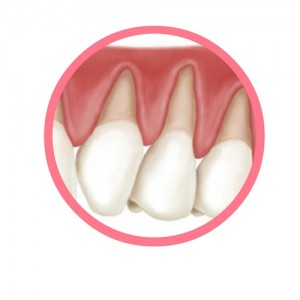Receding Gums: A Gradual And Common Dental Problem

This is the process during which the margin of the gum tissue that surrounds the teeth begins to wear away, and the actual root of the tooth may become exposed. When this wear and tear occurs, gaps form between the teeth and gum line, and they make it easy for bacteria to build up over time.

When the condition is left untreated, severe damage can occur that affects the supporting tissue and bone structure of the teeth, and in some of the worst cases, tooth loss may occur. Since it does occur on a very gradual timeline, it can be hard for some to pinpoint, and realize exactly what’s happening to them.
Sometimes you may notice that a tooth looks longer than normal, and you can run the tongue around by the gum line and feel a notch. This is a very common problem, and like many other conditions, not something that you want to ignore at all.
Whenever you noticed this condition on your mouth, don’t wait until gets worse, make contact to a 24 hour dentist.
What are the causes for receding gums?
A patient’s genes and hereditary patterns have a bit to do with whether or not they are prone to gum disease, and so for some, it doesn’t matter how well they care for their teeth. Around 30% of the population has a genetic predisposition for gum disease.
Once a patient already has periodontal disease, the bacterial gum infections that can harshly destroy tissue contribute greatly to this condition as well. Periodontal disease and other categories of gum disease overall are typically the main cause of this condition.
Even though patients have been taught to brush frequently, sometimes very aggressive tooth brushing can cause the enamel on the teeth to ultimately wear down. It may take a very long period of time, and some find it hard to believe, but very firm bristles and stiff, hard brushing can contribute to this condition.
During a woman’s lifetime, there are many different hormonal changes like puberty and pregnancy that can put the gums in a state that is vulnerable to gum recession. At the junction of a woman’s life where she begins to go through menopause, these same hormone levels can also provide the changes that make you prone to this.
Tobacco use is a huge culprit for this and many other health problems. These products produce a very sticky plaque that is very persistent. Years of tobacco use can definitely cause gum recession, and another reason to steer clear of it is that it will drastically stain your teeth as well.
Those that end up with gum disease also may have clenched and ground their teeth for years: the force that is put on the teeth can cause them over years. There are so many who grind and clench their teeth that aren’t even aware of it! Linked to stress and anxiety, there are many who start to do this with their teeth when they get nervous.
““Aggressive brushing with a medium- or hard-bristle brush over time can cause the gums to recede and expose root surfaces to the oral environment, causing root sensitivity. I know about this subject firsthand because I was provided with a hard-bristled brush and taught to scrub my teeth as a child.
When I went to dental school, I had a professor say to me “The object is to remove plaque. You are not scrubbing the bathroom floor.” It changed my thoughts about brushing. I got a soft-bristled brush and started treating my teeth and gums more kindly.””
Some of the best treatment options for gum recession
Much like periodontal disease, scaling and root planning is a great solution for treatment. The plaque and tartar that has built up after much time here are removed carefully. After this process when antibiotics are applied to the pockets and other areas, it greatly helps them heal. Scaling and root planning can be done in numerous sessions: taking care of one side of the mouth at a time can ease the process, and you may be even given sedation dentistry options during it.
What type of surgeries can remedy receding gums?
Pocket depth reduction is a procedure during which the dentist actually folds back the gum tissue, and expertly removes the harmful bacteria from the pockets. Then, the gum tissue is secured until it is placed directly over the root of the tooth, which makes sure that the pockets are reduced in size.
If the problem at hand has become dire enough that the bones supporting your teeth have become affected, a regeneration procedure may be a great option for care. This calls for the use of a tissue-stimulating protein or membrane that is applied after pocket depth reduction, and than the gum tissue is replaced back over the root of the tooth to heal.
A soft tissue graft is a surgical treatment that can help greatly when this condition has progressed. During this procedure, the roof of the mouth is surveyed for a flap of skin to be used in the process. The tissue gleaned here is then stitched to the gum tissue that is surrounding the root that is painful and exposed. One positive trait of this process is that you have not had too much deterioration yet, the skin can be obtained from closer to the tooth instead of the roof of the mouth.
The best ways to prevent receding gums
Avoiding acidic foods such as citrus fruits, pasta, drinking alcohol, coffee, and black tea in overindulgence can definitely help prevent receding gums. Especially the citrus and fermented elements like alcohol can really wear down the important protective layer of your teeth.
Brushing every day is always essential, as many dentists educate early on the educational road. The myth that a stiff bristle is the best for every brushing does not always hold true, and using a softer one the proper way will still keep your teeth rid of most debris, and provide less stress or wear and tear on the gums.
Medically Fact-Checked & Written by Our Dental Editorial Team
You can read more about our editorial guidelines by clicking this link and learn more about the Emergency Dentists USA editorial team here.






